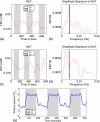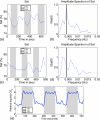Monitoring of hemodynamic changes induced in the healthy breast through inspired gas stimuli with MR-guided diffuse optical imaging
- PMID: 20443485
- PMCID: PMC2852445
- DOI: 10.1118/1.3358123
Monitoring of hemodynamic changes induced in the healthy breast through inspired gas stimuli with MR-guided diffuse optical imaging
Abstract
Purpose: The modulation of tissue hemodynamics has important clinical value in medicine for both tumor diagnosis and therapy. As an oncological tool, increasing tissue oxygenation via modulation of inspired gas has been proposed as a method to improve cancer therapy and determine radiation sensitivity. As a radiological tool, inducing changes in tissue total hemoglobin may provide a means to detect and characterize malignant tumors by providing information about tissue vascular function. The ability to change and measure tissue hemoglobin and oxygenation concentrations in the healthy breast during administration of three different types of modulated gas stimuli (oxygen/ carbogen, air/carbogen, and air/oxygen) was investigated.
Methods: Subjects breathed combinations of gases which were modulated in time. MR-guided diffuse optical tomography measured total hemoglobin and oxygen saturation in the breast every 30 s during the 16 min breathing stimulus. Metrics of maximum correlation and phase lag were calculated by cross correlating the measured hemodynamics with the stimulus. These results were compared to an air/air control to determine the hemodynamic changes compared to the baseline physiology.
Results: This study demonstrated that a gas stimulus consisting of alternating oxygen/carbogen induced the largest and most robust hemodynamic response in healthy breast parenchyma relative to the changes that occurred during the breathing of room air. This stimulus caused increases in total hemoglobin and oxygen saturation during the carbogen phase of gas inhalation, and decreases during the oxygen phase. These findings are consistent with the theory that oxygen acts as a vasoconstrictor, while carbogen acts as a vasodilator. However, difficulties in inducing a consistent change in tissue hemoglobin and oxygenation were observed because of variability in intersubject physiology, especially during the air/oxygen or air/carbogen modulated breathing protocols.
Conclusions: MR-guided diffuse optical imaging is a unique tool that can measure tissue hemodynamics in the breast during modulated breathing. This technique may have utility in determining the therapeutic potential of pretreatment tissue oxygenation or in investigating vascular function. Future gas modulation studies in the breast should use a combination of oxygen and carbogen as the functional stimulus. Additionally, control measures of subject physiology during air breathing are critical for robust measurements.
Figures









Similar articles
-
Detecting gas-induced vasomotor changes via blood oxygenation level-dependent contrast in healthy breast parenchyma and breast carcinoma.J Magn Reson Imaging. 2016 Aug;44(2):335-45. doi: 10.1002/jmri.25177. Epub 2016 Feb 21. J Magn Reson Imaging. 2016. PMID: 26898173 Free PMC article.
-
Inspired gas-induced vascular change in tumors with magnetic-resonance-guided near-infrared imaging: human breast pilot study.J Biomed Opt. 2010 May-Jun;15(3):036026. doi: 10.1117/1.3430729. J Biomed Opt. 2010. PMID: 20615028 Free PMC article.
-
Noninvasive monitoring of carbogen-induced changes in tumor blood flow and oxygenation by functional magnetic resonance imaging.Int J Radiat Oncol Biol Phys. 1995 Nov 1;33(4):855-9. doi: 10.1016/0360-3016(95)00072-1. Int J Radiat Oncol Biol Phys. 1995. PMID: 7591894
-
Magnetic resonance imaging techniques for monitoring changes in tumor oxygenation and blood flow.Semin Radiat Oncol. 1998 Jul;8(3):197-207. doi: 10.1016/s1053-4296(98)80045-3. Semin Radiat Oncol. 1998. PMID: 9634496 Review.
-
Investigating the Vascular Phenotype of Subcutaneously and Orthotopically Propagated PC3 Prostate Cancer Xenografts Using Combined Carbogen Ultrasmall Superparamagnetic Iron Oxide MRI.Top Magn Reson Imaging. 2016 Oct;25(5):237-243. doi: 10.1097/RMR.0000000000000102. Top Magn Reson Imaging. 2016. PMID: 27748709 Free PMC article. Review.
Cited by
-
Heterodyne frequency-domain multispectral diffuse optical tomography of breast cancer in the parallel-plane transmission geometry.Med Phys. 2016 Jul;43(7):4383. doi: 10.1118/1.4953830. Med Phys. 2016. PMID: 27370153 Free PMC article.
-
Near infrared transillumination imaging of breast cancer with vasoactive inhalation contrast.Biomed Opt Express. 2010 Jul 27;1(1):295-309. doi: 10.1364/boe.1.000265. Biomed Opt Express. 2010. PMID: 21258467 Free PMC article.
-
Direct Regularization From Co-Registered Contrast MRI Improves Image Quality of MRI-Guided Near-Infrared Spectral Tomography of Breast Lesions.IEEE Trans Med Imaging. 2018 May;37(5):1247-1252. doi: 10.1109/TMI.2018.2794548. IEEE Trans Med Imaging. 2018. PMID: 29727287 Free PMC article.
-
Impact of physiological noise correction on detecting blood oxygenation level-dependent contrast in the breast.Phys Med Biol. 2017 Jan 7;62(1):127-145. doi: 10.1088/1361-6560/62/1/127. Epub 2016 Dec 14. Phys Med Biol. 2017. PMID: 27973353 Free PMC article.
-
Improving vascular imaging with co-planar mutually guided photoacoustic and diffuse optical tomography: a simulation study.Biomed Opt Express. 2020 Jul 16;11(8):4333-4347. doi: 10.1364/BOE.385017. eCollection 2020 Aug 1. Biomed Opt Express. 2020. PMID: 32923047 Free PMC article.
References
-
- Vaupel P., Kallinowski F., and Okunieff P., “Blood flow, oxygen and nutrient supply, and metabolic macroenvironment of human tumors: A review,” Cancer Res. CNREA8 49, 6449–6465 (1989). - PubMed
-
- Brizel D. M., Scully S. P., Harrelson J. M., Layfield L. J., Bean J. M., Prosnitz L. R., and Dewhirst M. W., “Tumor oxygenation predicts for the likelihood of distant metastases in human soft tissue sarcoma,” Cancer Res. CNREA8 56(5), 941–943 (1996). - PubMed
-
- Nordsmark M., Bentzen S. M., Rudat V., Brizel D., Lartigau E., Stadler P., Becker A., Adam M., Molls M., Dunst J., Terriis D. J., and Overgaard J., “Prognostic value of tumor oxygenation in 397 head and neck tumors after primary radiation therapy. An international multi-center study,” Radiother. Oncol. RAONDT 77(1), 18–24 (2005).10.1016/j.radonc.2005.06.038 - DOI - PubMed
-
- Evans N. T. S. and Naylor P. F. D., “The effect of oxygen breathing and radiotherapy upon the tissue oxygen tension of some human tumours,” Br. J. Radiol. BJRAAP 36(426), 418–425 (1963).10.1259/0007-1285-36-426-418 - DOI
-
- Henk J. M., “Late results of a trial of hyperbaric-oxygen and radiotherapy in head and neck-cancer—A rationale for hypoxic cell sensitizers,” Int. J. Radiat. Oncol., Biol., Phys. IOBPD3 12(8), 1339–1341 (1986). - PubMed
Publication types
MeSH terms
Substances
Grants and funding
LinkOut - more resources
Full Text Sources
Medical
Research Materials

